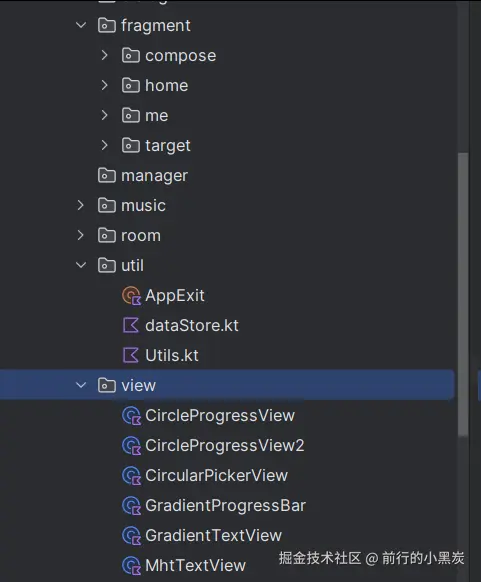目录
- 为什么需要提升代码的可扩展性?有什么问题?
- 比如我们写一个环境噪音分析逻辑。【对功能进行封装】
- 自定义view
- 分类管理
一、为什么需要提升代码的可扩展性?有什么问题?
比如我们要开发多个项目,那么很多项目,有很多内容都是相同的,所以我们需要复制过去,比如一些常用的自定义view,或者功能。
但往往我们复制过去的时候,就会发现有很多地方需要修改,甚至太多逻辑粘合在一起了,就导致我们复制要花很长的时间。
所以这篇文章就像来讲讲这个问题,以及解决方法。
1.1 比如我们写一个环境噪音分析逻辑。【对功能进行封装】
我们先来看看代码
kt
class MainActivity : AppCompatActivity() {
private lateinit var dbValueTextView: TextView
private lateinit var progressBar: ProgressBar
private lateinit var statusTextView: TextView
private var audioRecord: AudioRecord? = null
private var recording = false
private val bufferSize = 1024
private val handler = Handler(Looper.getMainLooper())
private val updateInterval = 500L // 更新间隔(毫秒)
override fun onCreate(savedInstanceState: Bundle?) {
super.onCreate(savedInstanceState)
setContentView(R.layout.activity_main)
dbValueTextView = findViewById(R.id.dbValueTextView)
progressBar = findViewById(R.id.progressBar)
statusTextView = findViewById(R.id.statusTextView)
checkPermission()
}
private fun checkPermission() {
if (ActivityCompat.checkSelfPermission(
this,
Manifest.permission.RECORD_AUDIO
) != PackageManager.PERMISSION_GRANTED
) {
ActivityCompat.requestPermissions(
this,
arrayOf(Manifest.permission.RECORD_AUDIO),
REQUEST_RECORD_AUDIO_PERMISSION
)
} else {
startNoiseMeasurement()
}
}
override fun onRequestPermissionsResult(
requestCode: Int,
permissions: Array<String>,
grantResults: IntArray
) {
super.onRequestPermissionsResult(requestCode, permissions, grantResults)
if (requestCode == REQUEST_RECORD_AUDIO_PERMISSION && grantResults.isNotEmpty() &&
grantResults[0] == PackageManager.PERMISSION_GRANTED
) {
startNoiseMeasurement()
}
}
//进行噪音分析
private fun startNoiseMeasurement() {
val minBufferSize = AudioRecord.getMinBufferSize(
SAMPLE_RATE,
AudioFormat.CHANNEL_IN_MONO,
AudioFormat.ENCODING_PCM_16BIT
)
audioRecord = AudioRecord(
MediaRecorder.AudioSource.MIC,
SAMPLE_RATE,
AudioFormat.CHANNEL_IN_MONO,
AudioFormat.ENCODING_PCM_16BIT,
minBufferSize
)
recording = true
audioRecord?.startRecording()
Thread {
val buffer = ShortArray(bufferSize)
while (recording) {
val readResult = audioRecord?.read(buffer, 0, bufferSize) ?: 0
if (readResult > 0) {
val amplitude = calculateAmplitude(buffer)
val db = amplitudeToDb(amplitude)
handler.post {
updateUI(db)
}
}
Thread.sleep(updateInterval)
}
}.start()
}
private fun calculateAmplitude(buffer: ShortArray): Double {
var sum = 0.0
for (i in buffer.indices) {
sum += buffer[i].toDouble() * buffer[i].toDouble()
}
return sqrt(sum / buffer.size)
}
private fun amplitudeToDb(amplitude: Double): Double {
// 参考值:16位PCM最大值为32767
return 20 * log10(amplitude / 32767.0)
}
private fun updateUI(db: Double) {
val absDb = abs(db)
val displayValue = if (absDb.isNaN()) 0.0 else absDb
dbValueTextView.text = "%.1f dB".format(displayValue)
progressBar.progress = displayValue.toInt()
when {
displayValue < 30 -> statusTextView.text = "环境安静"
displayValue < 60 -> statusTextView.text = "正常环境"
displayValue < 80 -> statusTextView.text = "噪音较大"
else -> statusTextView.text = "噪音超标!"
}
}
override fun onDestroy() {
super.onDestroy()
recording = false
audioRecord?.stop()
audioRecord?.release()
}
companion object {
private const val SAMPLE_RATE = 44100
private const val REQUEST_RECORD_AUDIO_PERMISSION = 200
}
}让我解释一下这里面的功能:
- 动态请求麦克风权限
- 获取到以后,开始进行声音的数据分析,然后进行数据分析。
比如我们现在有一个需求,要在另外一个项目里面也增加一个噪音分析功能,现在项目小还好,如果后续我们想增加数据保存到数据库,增加统计表等等,那么很多代码的逻辑就会耦合在一起。我们复制起来就很麻烦。
那么我们如何做呢?就是将噪音分析功能,抽取出来,封装到一个类里面,然后提供方法给外面调用。比如:
kt
object NoiseMeter {
private var mediaRecorder: MediaRecorder? = null
private var isRecording = false
private var scope: CoroutineScope? = null
private var updateInterval: Long = 100L // 更新间隔(毫秒)
// 噪音数据流
private val _noiseLevelFlow = MutableStateFlow(NoiseData(0.0, NoiseStatus.QUIET))
val noiseLevelFlow: StateFlow<NoiseData> = _noiseLevelFlow.asStateFlow()
// 初始化
fun initialize(context: Context, scope: CoroutineScope, updateInterval: Long = 100L) {
if (this.scope != null) return // 避免重复初始化
this.scope = scope
this.updateInterval = updateInterval
}
// 开始测量
fun start(context:Context) {
val cacheDir: File = context.cacheDir
if (isRecording || scope == null) return
scope!!.launch {
try {
mediaRecorder = MediaRecorder().apply {
// 1. 设置音频源
setAudioSource(MediaRecorder.AudioSource.MIC)
// 2. 设置输出格式
setOutputFormat(MediaRecorder.OutputFormat.THREE_GPP)
// 3. 设置音频编码
setAudioEncoder(MediaRecorder.AudioEncoder.AMR_NB)
// 4. 设置输出文件(使用临时文件更安全)
val tempFile = File.createTempFile("temp_audio", ".3gp", cacheDir)
setOutputFile(tempFile.absolutePath)
prepare()
start()
}
isRecording = true
// 开始更新噪音数据
while (isRecording) {
val amplitude = mediaRecorder?.maxAmplitude?.toDouble() ?: 0.0
if (amplitude > 0) {
val db = 20 * log10(amplitude)
val status = when {
db < 40 -> NoiseStatus.QUIET
db < 70 -> NoiseStatus.NORMAL
else -> NoiseStatus.LOUD
}
_noiseLevelFlow.value = NoiseData(db, status)
}
delay(updateInterval)
}
} catch (e: Exception) {
e.printStackTrace()
Log.d("NoiseMeter", "start failed: ${e.message}")
releaseMediaRecorder()
}
}
}
private fun releaseMediaRecorder() {
try {
mediaRecorder?.stop()
mediaRecorder?.release()
} catch (e: Exception) {
Log.e("NoiseMeter", "Error releasing MediaRecorder: ${e.message}")
} finally {
mediaRecorder = null
isRecording = false
}
}
// 停止测量
fun stop() {
if (!isRecording) return
isRecording = false
mediaRecorder?.apply {
try {
stop()
release()
} catch (e: Exception) {
e.printStackTrace()
}
}
mediaRecorder = null
}
// 噪音数据类
data class NoiseData(
val decibels: Double,
val status: NoiseStatus
)
// 噪音状态枚举
enum class NoiseStatus {
QUIET, NORMAL, LOUD
}
}然后我们在fragment里面就可以这样拿到数据
kt
class HomeFragment : BaseViewBindingFragment<FragmentHomeBinding>() {
companion object {
fun newInstance() = HomeFragment()
}
override fun createViewBinding(container: ViewGroup?): FragmentHomeBinding {
return FragmentHomeBinding.inflate(layoutInflater)
}
override fun initUI() {
}
override fun initListener() {
lifecycleScope.launch {
NoiseMeter.noiseLevelFlow
.flowWithLifecycle(lifecycle, Lifecycle.State.STARTED)
.collect { noiseData ->
binding.noise.text = noiseData.toString()
}
}
}
override fun initData() {
}
}1.2 自定义view
我们写了一个自定义view,比如是一个自定义的TextView,可能每个项目都不一样,比如他们的字重,字体等等,如果你想修改,那么提供一些自定义属性给外面,不要代码里面修改,比如加什么背景色等等,而是要想下面一样,提供属性,比如字重属性,这样后续迁移也很方便。
kt
class MhtTextView : AppCompatTextView {
constructor(context: Context) : super(context) {
init(null)
}
constructor(context: Context, attrs: AttributeSet?) : super(context, attrs) {
init(attrs)
}
constructor(context: Context, attrs: AttributeSet?, defStyleAttr: Int) : super(
context,
attrs,
defStyleAttr
) {
init(attrs)
}
private fun init(attrs: AttributeSet?) {
if (attrs != null) {
val a = context.obtainStyledAttributes(attrs, R.styleable.MhtTextView)
val weight = a.getInt(R.styleable.MhtTextView_mhtTextWeight, NORMAL)
applyFontWeight(weight)
a.recycle()
}
}
private fun applyFontWeight(weight: Int) {
// 应用字重
when (weight) {
MEDIUM -> setTypeface(ResourcesCompat.getFont(context, R.font.mht_medium))
BOLD -> setTypeface(ResourcesCompat.getFont(context, R.font.mht_bold))
else -> setTypeface(ResourcesCompat.getFont(context, R.font.mht_regular))
}
}
companion object {
private const val NORMAL = 0
private const val MEDIUM = 1
private const val BOLD = 2
}
}1.3 分类管理
比如view,就统一放到view包里面 比如功能模块,home,那么repository,viewmodel,framgnet,如果你还有些compose,也可以放到里面。都是方便迁移。
